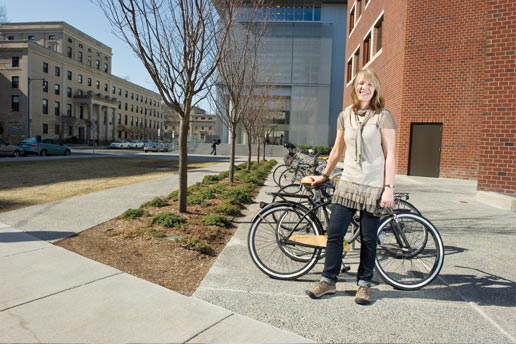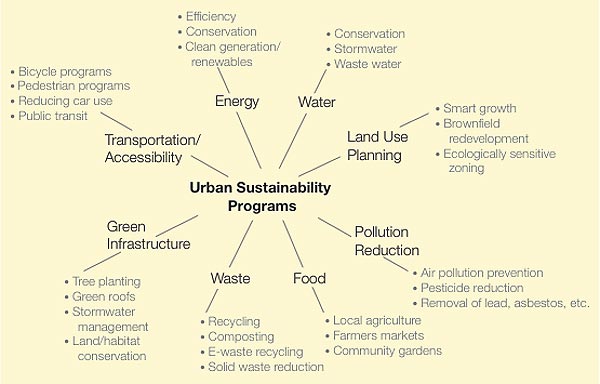
Overview
In cities across the country, bike-sharing plans, tree-planting initiatives, and other programs aimed at enhancing urban sustainability are becoming increasingly popular. As mayors consider how to design and implement their own programs, they can turn for guidance to a series of MIT assessments of what kinds of programs have worked—and not worked—in other cities and why. The MIT director of the assessment project is now developing a systematic, user-friendly method of presenting this information as well as a protocol that will permit easy or even automatic updating of the content. Her next task: determining the environmental benefits that actually accrue from specific urban sustainability programs.
At one time, cities were seen as dark, dirty hubs of consumption, degrading to both people and the environment. But recently, environmentalists have recognized that dense, compact cities are, in many ways, environmentally friendly. For example, people reside in relatively small spaces and close together; shared walls and short travel distances make for efficient energy use. What is more, urban leaders have stepped in where national-level politicians have been unwilling to act. As a result, cities are now leaders in the pursuit of sustainability. More than 1,000 mayors have signed the Mayors’ Climate Protection Agreement, vowing to meet the targets of the Kyoto Protocol. While that agreement was initially a response to federal inaction on climate change, city leaders have since realized that “being green” has multiple benefits: It makes cities more sustainable, enhances their livability, and attracts new residents, drawing people back into urban areas that are inherently more efficient. “By the mid-2000s, US cities were competing to see who could be the most green,” says Judy Layzer, associate professor of environmental policy and head of Environmental Policy and Planning in MIT’s Department of Urban Studies and Planning.
Many US cities are now devising and implementing sustainability programs aimed at everything from increasing bicycle use to expanding renewable power generation to cleaning up and conserving water. In 2008, Layzer became intrigued with such urban programs. Supported by a seed grant from the MIT Energy Initiative, she began to develop the first systematic assessment of ongoing sustainability programs—a source of integrated information that city leaders interested in sustainability will find invaluable. “Imagine that you’re a mayor and you want to start a bike-share program,” says Layzer. “If it fails, you don’t get to try it again. Politics is very unforgiving.” To design the best possible program, you would read case studies, search the Internet, and call your mayoral counterparts in other cities. But that is a scattershot way to gather information. When Layzer’s work is finished, you will instead consult a website created by her group and find a systematic analysis of how different approaches have led to different results in different settings or contexts.
Gathering data
To begin, Layzer assembled a team of students to assess five types of programs: tree-planting, light-rail systems, green stormwater infrastructure, urban parks, and composting. Each assessment started with a careful selection of US cities to target—some that have effective programs, some that have less-effective programs, and some that have tried and failed. The students then reviewed relevant documents and performed in-depth interviews to get details about the design of each city’s program; the political and social factors that may have affected its implementation; how program officials overcame any obstacles (if they did); and the program’s actual operation. After more than a year’s work, the students are now finalizing their assessments and thinking about how best to present the information they gathered.

Urban sustainability program areas. Diagram: Stephanie Stern, MA ’11, MIT
Two examples demonstrate what a city leader can learn from the assessments. Suppose you want to start a tree-planting program—a good way to improve local air quality, reduce the need for cooling, and enhance the livability of your city. You face two big problems: inadequate funding and finding places to plant thousands of new trees. Giving away seedlings at public events might seem an effective and popular way to deal with both of those problems—but the MIT assessment of tree-planting initiatives shows that others have run into trouble with such programs. In Los Angeles, for example, a tree giveaway elicited a public outcry and unfavorable press citing the irresponsibility of giving away trees that would end up in people’s apartments or trash or—if they were actually planted—left to die untended. Portland required recipients to pay a small fee to show their commitment to planting and maintenance, but then there were few takers. One place to watch is Philadelphia, which has been piloting various tree-giveaway models to test what works and what doesn’t before initiating a large-scale effort. Several cities are undertaking demonstration plantings at publicly controlled sites such as libraries to show people the benefits of trees and build community support.
Tree-siting methods and strategies for success
| Method | Strategies |
|---|---|
| Tree giveaways |
|
| Tree rebates |
|
| Right-of-way planting |
|
| Other |
|
Now consider a program to install a light-rail system—a move that could help relieve highway congestion, expand commuting choices, reinvigorate urban centers, and more. You know that getting voter approval to fund and implement the new light-rail line will be difficult. According to the MIT assessment, you can increase your odds of success by having a referendum that addresses multiple transportation modes rather than just light rail. But your best bet is to use existing funds to build a demonstration line and then present a referendum to fund future expansion. In Dallas and Salt Lake City, for example, people who initially opposed light-rail construction in their communities saw the success of the initial line elsewhere and subsequently lobbied for an extension into their areas. To improve your chances of winning over voters, you should place your new line on a corridor with many potential riders, avoid delays and cost overruns during construction, and involve the affected community in the design process.
General advice for planners
What general messages can mayors glean from the work to date? According to Layzer, a critical first step is to know your city. “The part I find fascinating that’s not often discussed or researched is all the ways that implementation can fail because you didn’t think about some aspect of the target—the entity whose behavior you’re trying to influence,” she says.
One key variable is a city’s attitude toward environmental action. San Francisco, Austin, Boulder, and Minneapolis, for example, are thought to have a strong environmental ethic, which may contribute to those cities’ ability to adopt aggressive sustainability policies. Indeed, in some cases, environmental ethic may trump other seemingly obvious influences, such as climate. Minneapolis, for instance, has cold, snowy winters and yet is a leader in bicycle programs; when winter comes, the bike-share stations are simply removed until spring.
The propensity to accept or resist rules may also influence the form of a city’s programs. New York, for example, has a culture of rules, fines, and compliance. In 2009, New York City instituted a rule prohibiting retail establishments that are running air conditioners from propping their doors open on hot days. Few stores complied—until the city began fining stores and issuing warnings, and compliance began to rise. “If you tried that approach in San Diego or Houston, you might get a lot more pushback,” says Layzer. In such cities, successful environmental programs are more likely to take the form of incentives or education than mandates.
In the end, different variables and city attributes matter for different kinds of programs—a complicating factor that the MIT teams try to address in their assessments. “One thing we talk about is that for this policy area, these kinds of city attributes can really matter,” says Layzer. “So it may be in the realm of, say, bike planning, New York can learn from Minneapolis but not from Chattanooga.” And while putting values on such attributes as environmental ethic may seem subjective, Layzer believes that long-term residents have a “pretty accurate sense” of their city’s culture and what would work and what would not.
Continuing work
Layzer and her team are now grappling with how best to present the assessment information so that people can use it and learn from it. Her goal is to produce a series of web-based tools that gives the visitor easy access to relevant, action-oriented analyses incorporating prose, graphics, and links to detailed supporting information. When those tools are available, she will ask various sustainability organizations to post them so that others can use, refine, and expand them.
She is also seeking a means of constantly updating the data so as to generate new assessments and analyses every few years. Her original concept was to have cities and students collaborate. “Cities have no money, but there are lots of universities with students who want real-world experience,” says Layzer. But as her own experience has shown, students have many demands on their time, and progress can be slow—and that is a problem for urban planners. “Wait too long and the political moment will have passed,” notes Layzer. She is hoping to speed the process by incorporating methods of automated data collection. “While the time-consuming, labor-intensive interviews would still be necessary, certain types of data could be collected automatically that could tell you a lot about a city,” she says.
Once she’s finished “inventing the method” and others are using and improving it, she plans to move onto the next piece: determining whether urban programs actually make a difference. It may seem obvious that they would—but perhaps not always. For example, if people get appliances that are more energy-efficient, they might use them more, causing overall energy use to increase rather than decrease. Similarly, the energy and environmental gains from requiring new buildings to be green may be less than predicted if those buildings are not used as efficiently as possible. Layzer recognizes that establishing a clear link between sustainability programs and measurable environmental impacts will be tricky. “You have to be clever about what you measure and how you figure out whether it was the program that caused the outcome or not,” she says. “It’ll be a totally different kind of challenge, but I think it’s worth a try.”
This research was funded by a seed grant from the MIT Energy Initiative. Work continues under a grant from the Summit Foundation. Further information can be found in:
J. Layzer and S. Stern. What Works and Why? Evaluating the Effectiveness of Cities’ Sustainability Initiatives. American Political Science Association Meeting, September 2–5, 2010, Washington, DC. Available at papers.ssrn.com/sol3/papers. cfm?abstract_id=1644156.
This article appears in the Spring 2012 issue of Energy Futures.